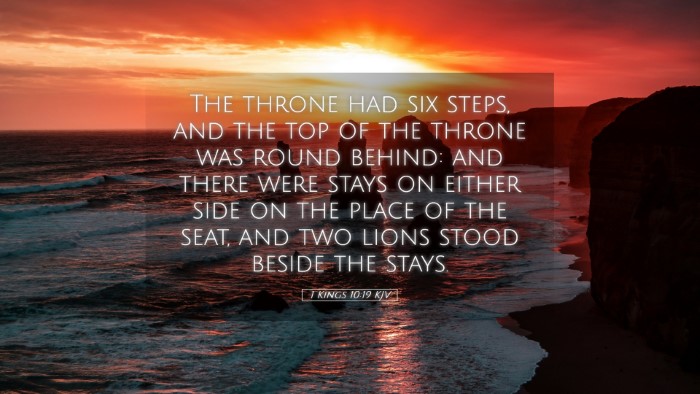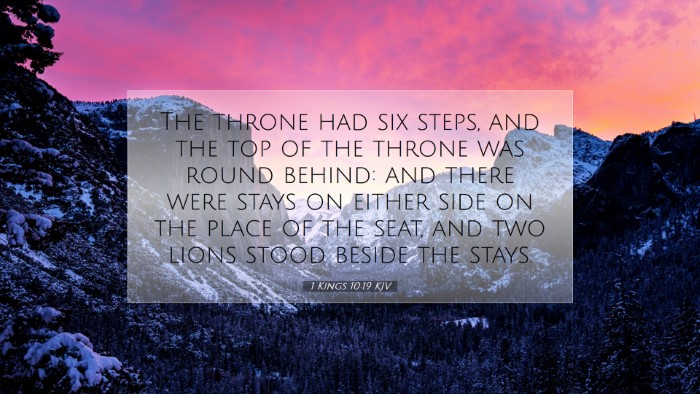Commentary on 1 Kings 10:19
Bible Verse: 1 Kings 10:19 - "The throne had six steps, and the top of the throne was round behind: and there were stays on either side on the place of the seat, and two lions stood beside the stays."
Introduction
The verse under consideration reflects the grandeur and majesty of King Solomon's throne, which is emblematic not only of his wealth and power but also of the wisdom and glory that God had bestowed upon him. The design of the throne, with its elaborate features, serves a deeper purpose than mere aesthetics, providing insights into the authority and rulership of Solomon in the context of his relationship with God and his people.
Historical Context
Solomon’s reign is marked by peace and prosperity, which stands in stark contrast to the tumultuous reigns of previous kings. The lavish descriptions of his court reflect the fulfillment of God's promise to David regarding his lineage. Solomon's wisdom results in international recognition, as seen in the visit of the Queen of Sheba to test his understanding and witness his wealth (1 Kings 10:1-3). The throne itself, described here, symbolizes the stability and righteousness of his rule.
Throne Description
The details given in 1 Kings 10:19 highlight several architectural features:
- Six Steps: The number six is often associated with man and human labor in scriptural symbolism. This could signify how man, despite his efforts, must look to God for ultimate authority and wisdom.
- Round Top: The roundness may symbolize eternity and completeness. It suggests that God's reign is everlasting and that Solomon's authority is complete under God's providence.
- Stays and Lions: The presence of lions conveys strength and majesty. In biblical symbolism, lions often represent not only physical might but also divine protection and judgment.
Theological Insights
This verse can illustrate various theological themes, notably the sovereignty of God, the importance of godly governance, and the divine approval of righteous rule:
- God's Sovereignty: Solomon’s throne represents God's chosen ruler who is to lead His people in righteousness. It reflects God's hand in the establishment of governance that honors Him.
- Justice and Righteousness: The design and grandeur of the throne reflect the responsibilities of the ruler to uphold justice. As Solomon was known for his wisdom, the throne also symbolizes the wise application of God's laws.
- Divine Favor: The intricate details signify God’s favor upon Solomon. This favor was critical in drawing nations to Israel, knowing that a wise and just ruler represents God's character to the world.
Insights from Commentaries
Matthew Henry
Henry emphasizes the importance of the throne not just as a seat but as a symbol of God's providence. He suggests that the design reflects the glory of Solomon's wisdom, inviting all nations to gather and seek counsel from this wise king. Henry also cautions that such grandeur must be accompanied by righteous living; the throne serves as a reminder to uphold God's laws faithfully.
Albert Barnes
Barnes provides insight into the significance of the throne's design elements. He explains how the six steps represent the dignity and elevation of the throne, while lions signify power and the protective aspects of kingship. Barnes notes that the intricate decorations denote how the kingdom of Israel, under Solomon, had reached a zenith of cultural and political development, attracting attention far and wide.
Adam Clarke
Clarke focuses on the importance of symbolism in the construction of the throne. He delves into the imagery of the lions, interpreting them as guardians of the king, which represents God’s protection over His appointed ruler. He further highlights how Solomon’s court, encapsulated by this throne, became a model for leadership that theologians should study to understand the attributes of divinely-sanctioned governance.
Practical Applications
For pastors, students, theologians, and Bible scholars, this passage offers rich ground for discussion on leadership, authority, and service:
- Leadership Models: Solomon serves as a model for those in leadership, demonstrating that authority should be exercised with wisdom, justice, and humility.
- Reflecting God's Character: Just as Solomon's throne reflected God's established order and wisdom, leaders today must ensure their governance echoes God’s justice, mercy, and righteousness.
- Symbolism in Worship: The intricate symbolism within Solomon's throne can inspire worship leaders to creatively express God’s majesty in church settings, drawing congregations into a deeper understanding of His sovereign rule.
Conclusion
1 Kings 10:19 offers a compelling glimpse into the grandeur of King Solomon’s reign that extends beyond aesthetics into profound theological insights. The description of the throne showcases God's provision of wisdom and authority, serving as a powerful reminder of the divine expectation for leaders to govern justly. By reflecting on this verse and the insights drawn from notable theologians, we glean invaluable lessons on leadership, divine sovereignty, and the nature of God's kingdom as exemplified in Old Testament Israel.


